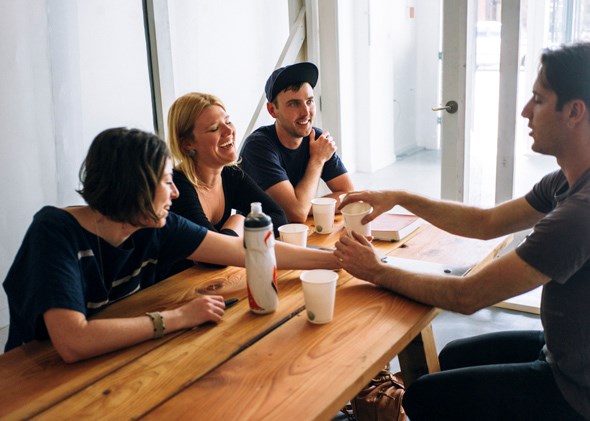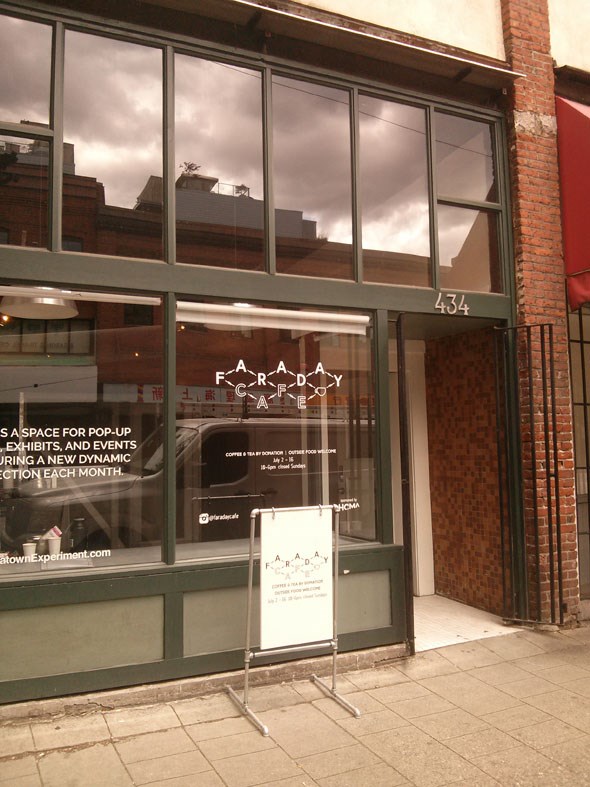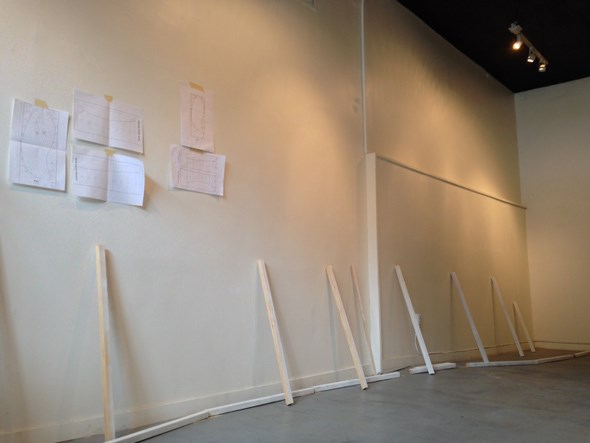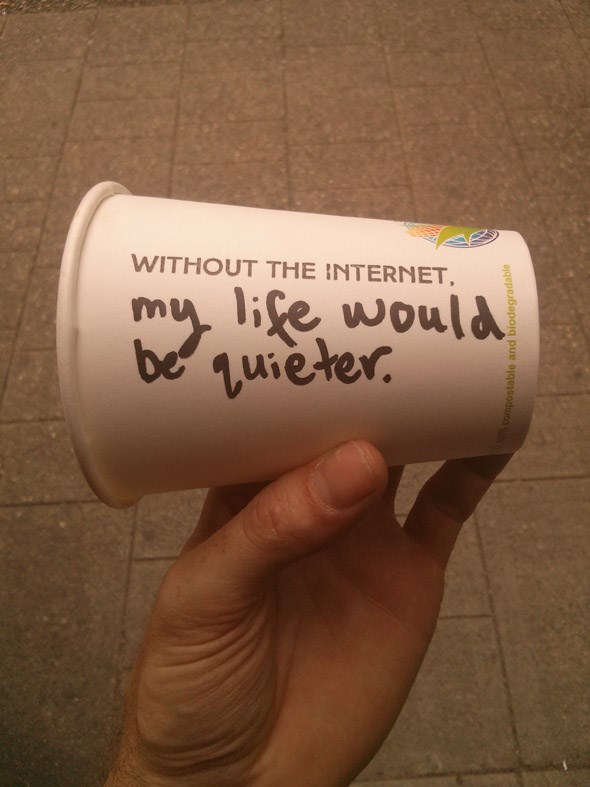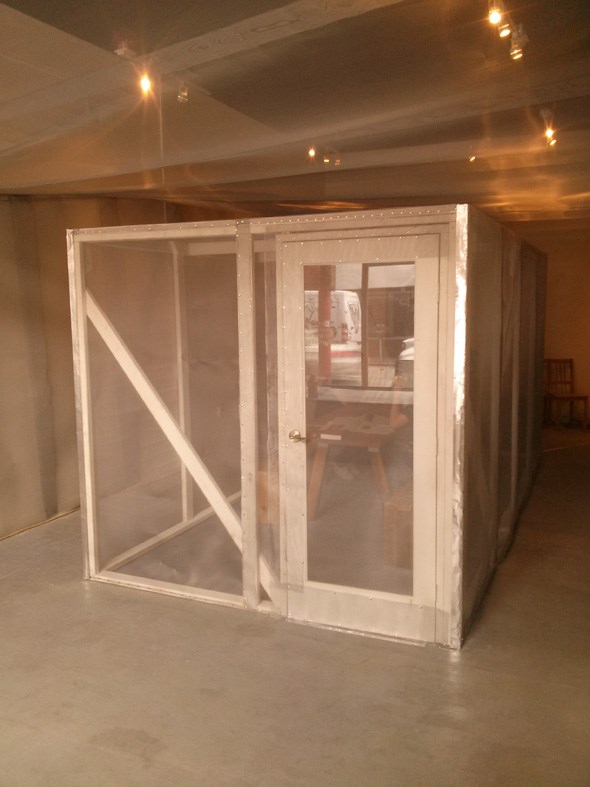 |
Vancouver Is Awesome is a proud sponsor of The Chinatown Experiment, a storefront dedicated to pop ups which provides anyone that has an idea and the desire to bring it to life with the opportunity to make it happen. Every time a new pop up is about to launch you'll catch a sneak peek here on V.I.A.! |
Earlier this month, Faraday Café stepped into 434 Columbia St. for a two week pop-up. I was away for the opening but was able to make it in on a few occasions. At first glance, the café was not the aesthetically pleasing design I had seen in the original sketch ups. Having been away and seeing the unprecedented media attention it received, it was disappointing to return to what at first glance looked a cage in a store.
It took a few visits to appreciate the concept. It was when I had to leave the café when expecting a phone call that it really struck me; in this small Chinatown storefront I was suddenly disconnected from the vast digital network and could not help but appreciate the irony of having to step into a cage to escape the distractions of constantly being accessible in the city.
With the long weekend ahead of us, it’s a good time to reflect back on Faraday Café. Although the pop-up is now over, you don't need to step into a cage to disconnect. If you can get out of town and off the grid, do it. And if you're staying in the city, turn your phone off – you can give yourself an hour in the morning to check email and make plans for the day. Give it a shot, leave the phone at home, step out of the cage, and on Tuesday morning share your experience to inspire others to do the same.
We chatted with social artist and Faraday Café founder, Julien Thomas, as he shared his experience and reflected back on the pop-up.
In a few words, how would you summarize your entire experience around the Faraday Café?
Unexpected, Varied, Thought provoking.
How was it working with the architects at HCMA?
It was good. Because it was the first artist residency, they didn’t have many ground rules or expectations. It was quite open and pretty informal. I presented at the firm and then came over for a few days afterward and we went through ideas over lunch. I tested some things and then came back to them.
It was pretty casual, pretty free. But I guess I should’ve taken a cue when we decided to design the structure using a computer to do a project that was trying to repel digital. One of the lessons I learned, the algorithm for Google Sketch Up, kind of hides some of the material aspects that were really important to the project. So we had to act really quickly and amend our design a few days before opening. It’s something that if we had more time would’ve been able to figure out. The idea that you could design something that obscure, and it’ll translate over… We could achieve so much through a computer and it’ll get us to a place that we want to be, is fraught with issues. And that’s something we were trying to examine in the project and it came up in the actual design phase as well.
The building of the actual structure was an experiment in itself…
Yes. I worked over the weekend with two of the architects and we tried to build what we came up with, in the computer and it just wasn’t going to work. So we learned some lessons pretty quickly about how the material acted and the design was… it was a Plan B. But, it ended up working just fine. It helped to illustrate some of the issues we were looking at. It worked out in the end.
Any future collaborations that we can look forward to?
HCMA is looking to work with other artists, to roll out projects with dancers, writers, painters, photographers, musicians, installation artists. They want to do a lot of different collaborations. I believe they’re in discussions with a few different artists.
The café received quite a bit of attention from the media and a positive response from the community. Was this something you anticipated or were you surprised? What was your reaction?
I’m always trying to spread messages through conversation. Whether that’s someone seeing something and passing it on in a conversation with their friends or family, or whether that’s through the media. It’s important.
The concepts and the projects operate on an almost societal level. I’m not saying we get coverage for everybody. Eighteen different articles and hundreds of shares, a lot of people were exposed to the concept and that’s one metric of success that I’m trying to achieve and was able to get more than I expected. That being said, a lot of the articles that were mediated in some way, that weren’t live discussions (like live TV or radio), were diluted and a lot of the core ideas were lost. Again, this telling about the whole concept, if you’re trying to share ideas through media, like using smart phones, the ratio of digital technology tends to dumb things down and bring it to it’s lowest common denominator. So, a lot of the media articles would end with “Well what do you think, is this a good business idea? Will this work out in the end?” Any simple conversation with me, the journalist would know this is not a business idea. It’s an installation that provokes thought. And so, they didn’t get it and it’s kind of sad, Pop Up City and Fast Company did some of the best articles. They took the essence of what I was trying to say and didn’t adulterate it like the mainstream media tends to do. So again, there’s this manipulation – it’s not intentional, things get lost through mediation. Media coverage is one metric of success but it’s also fraught with it’s own issues, just like with the Google Sketch Up.
It seemed that the people who went to the café grasped the idea quite well…
I’d say we had several hundred people come in over the two weeks. We also had over a hundred come to our events in the evening. So there were a lot of direct experiences and I think overall they were positive and some great conversations being had. You could see when people left their thoughts on the cup or conversations inside, you could see people were really trying to engage with the issue – the people that showed up.
Do you think Vancouver could benefit from having a permanent space like this? What’s your feeling after having the pop-up?
I definitely see the value in having a permanent space, whether it’s for therapeutic reasons or for productivity reasons, or just to provide an alternative space. I think there’s value in the prospect. Whether it’s a sustainable business – you’d have to work the idea a little more. For example, the coffee shops in the area don’t just sell coffee. One sells furniture, one sells motorcycle parts, one sells food. Having an overlap of a draw, for people to come and stay and use the space. Finally, community isn’t built in two-weeks, it takes more time and a sustained effort.
So you did the cafe and it was a great experience but you probably wouldn’t do it again?
I’ve been approached by a potential client that wants me to build three more cafés in Chicago, Milwaukee, and Madison. I’m dedicated to the concept and the implications of digital technology and spaces that don’t have it, that don’t provide it, or provide a respite against it. I’m more interested in thinking of those ideas and about the implications than I am about putting forth a viable business plan. I’m more about getting those ideas out there and strengthening our understanding of issues.
So there is potential, to do them [cafes] internationally or other Canadian cities?
If it gets the idea out there and allows people to experience it and have a conversation with it, then I’m interested in pursuing something like that.
It’s one component of a broader discussion that we’re having more often. When I was working at the café, I saw the cover of the Globe and Mail and it said “You’ve Got Mail But You Don’t Have To Open It” and it’s just one segment of a broader discussion that’s going on. There’s value in contributing a little piece to that larger puzzle.
With the completion of this project, do you have anything in the works or plans for the future?
I’m currently working on the Commercial Drive Parklet. We’re working on that currently. I’m going to Amsterdam to do a Masters in Fine Arts [at the Sandberg Institute] in the fall.
Additional thoughts?
One thing that I’ve been thinking about, the proposal I had given to HCMA, what happens when you create a space that is devoid of something? I don’t think we fully accomplished, spatially … People talked about the cage, and what are we keeping in or what are we keeping out. That’s a conversation that we had. But I think we could’ve gone further with that concept. That being said, when a space that is devoid of something it is dully a space that provides respite.
What I was surprised to see was people who had experienced electro-magnetic sensitivity issues. I came at this project from a social aspect and don’t claim to know much about, or am an authority on, the health issues that are at play. I found it interesting, when you create a space that is a respite, who comes … It’s usually people whose voices aren’t being heard or who don’t see their voice being represented. That took me a little bit by surprise, the people who showed up – I didn’t know these issues very well.
That was an insight for me; who shows up, why aren’t they being heard and what do they have to say. As the host of the space, it’s your job to listen.
